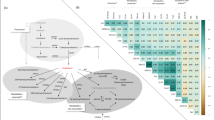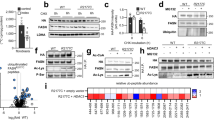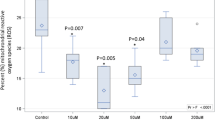Abstract
Background/Objectives:
Conversion of saturated fatty acids to monounsaturated fatty acids by the enzyme stearoyl-Co-A-desaturase (SCD-1) is emerging as a major factor in promoting carcinogenesis including breast cancer. The aim of our study was to explore the regulation of SCD-1 by Raloxifene and omega-3 fatty acids in women at increased risk of breast cancer based on high breast density.
Subjects/Methods:
As a reflection of SCD-1 activity, we measured the ratios of palmitoleic acid (C16:1n7) to palmitic acid (C16:0) (SCD-16) and oleic acid (C18:1n9) to steric acid (C18:0) (SCD-18) in plasma samples of postmenopausal women enrolled in our clinical trial (NCT00723398) designed to test the effects of the antiestrogen, Raloxifene and/or the omega-3 preparation Lovaza, on breast density, a validated biomarker of breast cancer risk.
Results:
We report that Lovaza but not Raloxifene-reduced SCD-16 and SCD-18 for the 2-year duration of the trial. Importantly, decreasing levels of SCD-16 and SCD-18 were associated with a progressive reduction in breast density but only in obese women (body mass index ⩾30).
Conclusions:
Body mass index-related factors play an important role in the reduction of breast density and hence breast cancer risk by omega-3 fatty acids. SCD-1 may be a useful biomarker in future clinical trials testing the benefit of nutritional interventions in reducing obesity-associated breast cancer risk.
This is a preview of subscription content, access via your institution
Access options
Subscribe to this journal
Receive 12 print issues and online access
$259.00 per year
only $21.58 per issue
Buy this article
- Purchase on Springer Link
- Instant access to full article PDF
Prices may be subject to local taxes which are calculated during checkout




Similar content being viewed by others
References
Jiang W, Zhu Z, Thompson HJ . Dietary energy restriction modulates the activity of AMP-activated protein kinase, Akt, and mammalian target of rapamycin in mammary carcinomas, mammary gland, and liver. Cancer Res 2008; 68: 5492–5499.
Menendez JA, Lupu R . Fatty acid synthase and the lipogenic phenotype in cancer pathogenesis. Nat Rev Cancer 2007; 7: 763–777.
Igal RA . Roles of Stearoyl-CoA Desaturase-1 in the regulation of cancer cell growth, survival and tumorigenesis. Cancers (Basel) 2011; 3: 2462–2477.
Poudyal H, Brown L . Stearoyl-CoA desaturase: a vital checkpoint in the development and progression of obesity. Endocr Metab Immune Disord Drug Targets 2011; 11: 217–231.
Chajes V, Hulten K, Van Kappel AL, Winkvist A, Kaaks R, Hallmans G et al. Fatty-acid composition in serum phospholipids and risk of breast cancer: an incident case-control study in Sweden. Int J Cancer 1999; 83: 585–590.
Pala V, Krogh V, Muti P, Chajes V, Riboli E, Micheli A et al. Erythrocyte membrane fatty acids and subsequent breast cancer: a prospective Italian study. J Natl Cancer Inst 2001; 93: 1088–1095.
Vinknes KJ, Elshorbagy AK, Nurk E, Drevon CA, Gjesdal CG, Tell GS et al. Plasma stearoyl-CoA desaturase indices: association with lifestyle, diet, and body composition. Obesity (Silver Spring) 2013; 21: E294–E302.
Copland SA, McHardy KC, Wahle KW, Hutcheon AW . Altered platelet stearic to oleic acid ratio in malignancy. Eur J Cancer 1992; 28A: 1135–1137.
Ntambi JM, Miyazaki M . Recent insights into stearoyl-CoA desaturase-1. Curr Opin Lipidol 2003; 14: 255–261.
Chajes V, Joulin V, Clavel-Chapelon F . The fatty acid desaturation index of blood lipids, as a biomarker of hepatic stearoyl-CoA desaturase expression, is a predictive factor of breast cancer risk. Curr Opin Lipidol 2010; 22: 6–10.
Warensjo E, Riserus U, Vessby B . Fatty acid composition of serum lipids predicts the development of the metabolic syndrome in men. Diabetologia 2005; 48: 1999–2005.
Warensjo E, Riserus U, Gustafsson IB, Mohsen R, Cederholm T, Vessby B . Effects of saturated and unsaturated fatty acids on estimated desaturase activities during a controlled dietary intervention. Nutr Metab Cardiovasc Dis 2008; 18: 683–690.
Rudkowska I, Julien P, Couture P, Lemieux S, Tchernof A, Barbier O et al. Cardiometabolic risk factors are influenced by Stearoyl-CoA Desaturase (SCD) -1 gene polymorphisms and n-3 polyunsaturated fatty acid supplementation. Mol Nutr Food Res 2014; 58: 1079–1086.
Sandhu N, Schetter SE, Liao J, Hartman TJ, Richie JP, McGinley J et al. Influence of obesity on breast density reduction by omega-3 fatty acids: evidence from a randomized clinical trial. Cancer Prev Res (Phila) 2016; 9: 275–282.
Cuzick J, Warwick J, Pinney E, Duffy SW, Cawthorn S, Howell A et al. Tamoxifen-induced reduction in mammographic density and breast cancer risk reduction: a nested case-control study. J Natl Cancer Inst 2011; 103: 744–752.
Schetter SE, Hartman TJ, Liao J, Richie JP, Prokopczyk B, DuBrock C et al. Differential impact of body mass index on absolute and percent breast density: implications regarding their use as breast cancer risk biomarkers. Breast Cancer Res Treat 2014; 146: 355–363.
Manni A, Xu H, Washington S, Aliaga C, Cooper T, Richie JP Jr et al. The impact of fish oil on the chemopreventive efficacy of tamoxifen against development of N-methyl-N-nitrosourea-induced rat mammary carcinogenesis. Cancer Prev Res 2010; 3: 322–330.
Bjermo H, Riserus U . Role of hepatic desaturases in obesity-related metabolic disorders. Curr Opin Clin Nutr Metab Care 2010; 13: 703–708.
Jones BH, Maher MA, Banz WJ, Zemel MB, Whelan J, Smith PJ et al. Adipose tissue stearoyl-CoA desaturase mRNA is increased by obesity and decreased by polyunsaturated fatty acids. Am J Physiol 1996; 271: E44–E49.
Ntambi JM, Miyazaki M . Regulation of stearoyl-CoA desaturases and role in metabolism. Prog Lipid Res 2004; 43: 91–104.
Ntambi JM . Regulation of stearoyl-CoA desaturase by polyunsaturated fatty acids and cholesterol. J Lipid Res 1999; 40: 1549–1558.
Acknowledgements
This work has been funded by Susan G. Komen for the Cure, KG081632 and pilot funds from the Penn State Hershey Cancer Institute. We thank GlaxoSmith Kline and Eli Lilly for their generous supply of Lovaza and Raloxifene, respectively.
Author information
Authors and Affiliations
Corresponding author
Ethics declarations
Competing interests
The authors declare no conflict of interest.
Rights and permissions
About this article
Cite this article
Manni, A., Richie, J., Schetter, S. et al. Stearoyl-CoA desaturase-1, a novel target of omega-3 fatty acids for reducing breast cancer risk in obese postmenopausal women. Eur J Clin Nutr 71, 762–765 (2017). https://doi.org/10.1038/ejcn.2016.273
Received:
Revised:
Accepted:
Published:
Issue Date:
DOI: https://doi.org/10.1038/ejcn.2016.273



